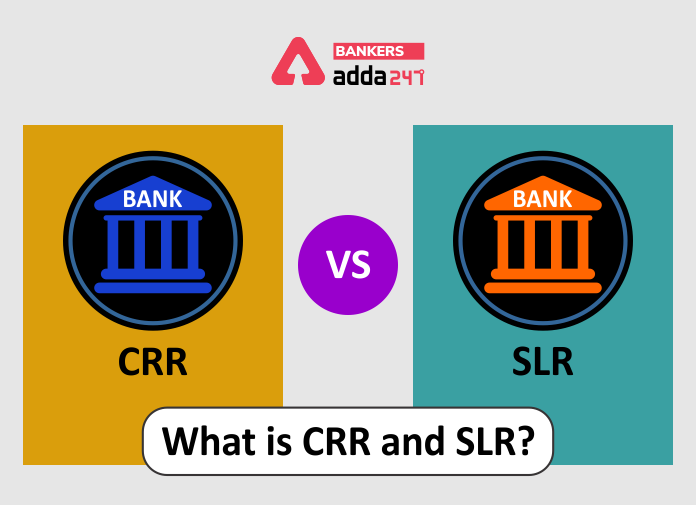Banking Awareness is one such topic that holds a lot of importance in Mains examination and we have seen in the past examination that a good percentage of the General Awareness section consists of banking awareness. This topic will also be useful while appearing for your Interview. In this article, we will be discussing one of the commonly used banking terms: CRR and SLR
Practice With,
Cash Reserve Ratio ( CRR)
The Cash Reserve Ratio is a money market instrument used by RBI to regulate the flow of money into the market. CRR is a certain percentage of total deposits that RBI instructs the commercial banks to keep as a reserve with RBI. This is one of the most important tools. This is a powerful tool to control the flow of money in the market. If the percentage of CRR is high, then bank deposit with RBI increases which leads to decrease in capacity of the bank to lend and thus increasing the interest rate as borrowing becomes expensive and flow of money in market decrease also inflation decreases, this is how CRR ratio is used as a money market tool to help to reduce inflation. Similarly, when the percentage of CRR ratio decreases, bank deposit with RBI decreases which leads to increase in capacity of the bank to lend and hence, interest rate decrease as borrowing becomes cheap and flow of money in market increase inflation increases or we can also say that the liquidity is an increase in the market. So, CRR can be considered an effective tool used by the RBI To control Inflation.
Thus we can conclude that CRR is inversely proportional to the liquidity in the market. If CRR is increased then liquidity will be decreased and if CRR is increased then liquidity will increase.
Let us understand better with an example.
Suppose a bank has 100 rupees and the CRR is 4%. So, the bank will give 4 rupees to the RBI and will be left with 96 rupees which will distribute in the market in the form of a loan. Now, the RBI has increased the CRR to 5% so the bank will have to give 5 rupees to RBI and will only be left with 95 rupees thus decreasing the lending power of the commercial bank.
Statutory Liquidity Ratio
SLR is the Statutory Liquidity Ratio is another instrument used by the RBI to regulate the flow of the money in the market as well as to meet the urgent demands of the depositors. SLR is not only maintained in monetary form but also in the form of cash, gold, other securities prescribe by RBI. The objective of maintaining SLR is to have an amount in the form of liquid assets which can be used to handle a sudden increase in demand for the amount from the depositor.
It is used by RBI to limit credit facilities offered by the bank to borrowers which maintain the stability of the bank. SLR is defined as a percentage of net time and demand liability kept by the bank. By net time and demand liability, we mean that the amount which is payable to the customer after interval and demand liability means the amount which is payable to the customer when he is demanding the same. SLR also protects the bank from a bank run situation and provides confidence to the customer in the banking system.
Let us understand with an example
If a bank has 100 rupees and SLR is 20% then banks have to keep those 20 rupees with them and cannot use them for lending purposes. Out of 100 banks is now left with 80 rupees which it can use to lend.

Difference Between CRR and SLR
| CRR | SLR |
| CRR is certain percentage of amount that banks have to keep with RBI | SLR is the ratio of deposit with banks that they have to keep with themselves. |
| CRR is maintained only in monetary form. | SLR can be maintained in form of Gold, Cash and other securities approved by RBI. |
| CRR is use to control the Inflation. | SLR is use to meet the sudden demand of the depositors. |
| CRR regulated Liquidity | SLR regulates credit facility |
| No interest is earn by banks on CRR | Banks can earn interest on SLR |
Frequently Asked Questions:
Q.What is the current CRR and SLR?
Ans. Current CRR is 3% and SLR is 18.5%.
Q. What is CRR?
Ans. CRR is the percentage of the deposit that banks have to keep with RBI.
Q. What is SLR?
Ans. SLR is the percentage of the deposit that banks have to keep with themselves.
Q. Why CRR and SLR is used?
Ans. CRR and SLR are two money markey instruments use to control inflation and meet the immediate demands of the depositors.
Q. What is the full form of CRR and SLR?
Ans. Full form of CRR is Cash Reserve Ration & SLR is Statutory Liquidity Ratio.
Click Here to Register for Bank Exams 2020 Preparation Material
Practice With,



 Weekly Current Affairs One Liners 23rd t...
Weekly Current Affairs One Liners 23rd t...
 CSIR CRRI Typing Test 2025 Date for JSA ...
CSIR CRRI Typing Test 2025 Date for JSA ...
 Can Final Year Students Apply for SBI PO...
Can Final Year Students Apply for SBI PO...


